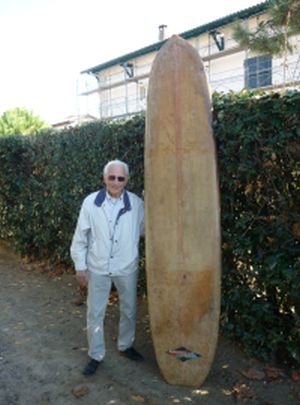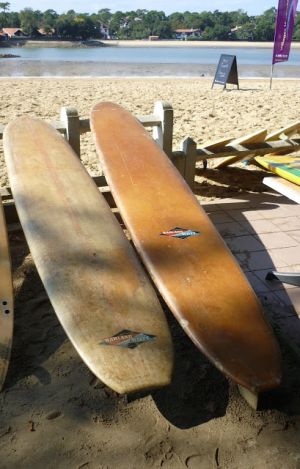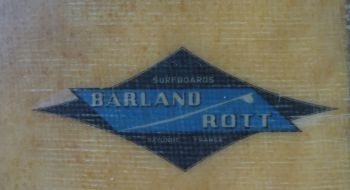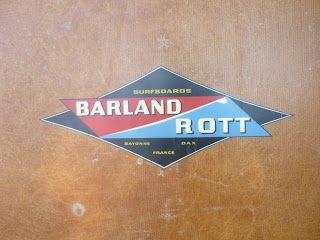A Paipo Interview with Jacky Rott
October 11, 2012. Dax, Landes, Southern West France
Interview by Philip Zibin based on questions by Bob Green
Editing and hosting, Rod Rodgers, MyPaipoBoards.org
Translation assistance from Philip Zibin, Guilhem Rainfray,
Benoit Mori, Lucie Josse and Benedicte Rott.
R.I.P. Jacky Rott (August 27, 1932 - June 7, 2019, age 87)
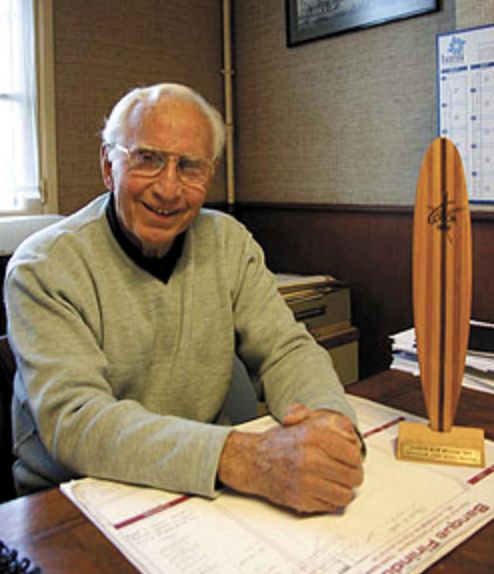
Jacky Rott in His Factory Office.
Photo courtesy of Alexandre Rott.
|
|
Jacky Rott has played a
central role in the development of surfcraft in France. Perhaps most
well known for his partnership with Michel Barland, Barland-Rott
surfboards were sold throughout Europe, even smuggled into Spain during
the Franco era.
Less well known was his role in making plankies, the curved nose wooden
bellyboards ridden from the late-1940s. The design of the curved nose
wooden planky has been attributed to Georges Hennebutte, a creative
man, whose inventions included an early leg rope and a rubber ducky
known as the Swordfish.
Both Hennebutte and Rott attempted to copy the surfboard of visiting
U.S. screenwriter Peter Viertel. Rott would go on to become one of the
pioneers of surfboard manufacturing in Europe.
In this interview, conducted seven years before his death on June 9,
2019, Jacky Rott recalls how he began making plankies, the forerunner
of the boogie board, which were ridden by young surfers of the day, as
well as his first attempts to ride and make surfboards.
|
1. So, I have a list of questions, and I don't think it will take too
much of your time. In fact, as I have notified you in the mail, an
Australian is behind this request. His name is Bob Green. He has a
website and he is interested in knowing everything about prone surfing,
specifically the paipo originating from a Hawaiian word.
Paipo is an Hawaiian term.
Yes, paipo are surfboards that Hawaiians used in the early days, but surfing prone.
But that had nothing in common with these ones because these paipo
boards that you are talking about, I saw people practicing on them. They are
flat planks, relatively long.
Not necessarily, sometimes they were about 6 feet, the height
of a man, or much shorter. And of course there were surfboards reserved
for the Hawaiian elite, the Olo, very large boards. So these kind of
boards would be for all Hawaiian people. And all people can surf then.
And Tahitians also use them because this came from Tahiti, too. So they
are interested in these kind of boards. [Editor's Note: These boards, about a person's height and less, were called pae po`o, now shortened to paipo, and alaia boards and more at MyPaipoBoards.org.]
By the way, there is a big polemic: Who was the first and who said that it was the Tahitians?
It's true, entirely true! There has been an immigration from
Tahiti to Hawaii and there has been some studies about it. And some
others about Peru, because some people imagine an immigration from Peru
to Tahiti and then—
The Peruvians don't have a great nautical history as navigators.
There are so many civilizations in Peru that have
disappeared, as they were pushed out by other civilizations from the
North. There are a lot of hypotheses and we are still trying to figure
it out.
In France, there is someone who is a very popular surfer. I don't know if you know him, it's Gibus de Soultrait.
Yes, Gibus de Soultrait, founder of Surf Session magazine.
Well, for him, it is surfing, surfing, surfing. It's a passion and
he sacrificed his passion for surfing in exchange for creating this
publication. He does a lot of research, he lives in Paris and he has a
very large book collection.
Moreover, this evening I had been invited to Bayonne, and precisely
during this event about surfing, he shared with me all his studies, the
research he had done. He told me Tahitians are supposedly the
founders of surfing.
Well, I am very similar to Gibus de Soultrait, as I collect
many old magazines and books on surfing. For example the whole
collection of John Severson's Surfer. He asked me if I had the
opportunity to go to mainland France, and today I am here, as I have
had the opportunity.
A Photo of Jacky
Rott's First Surfboard, a Solid Balsa Copy of
Peter Viertel's Surfboard, ca. 2012—This Board was Blue, His Brother André's Board was Red
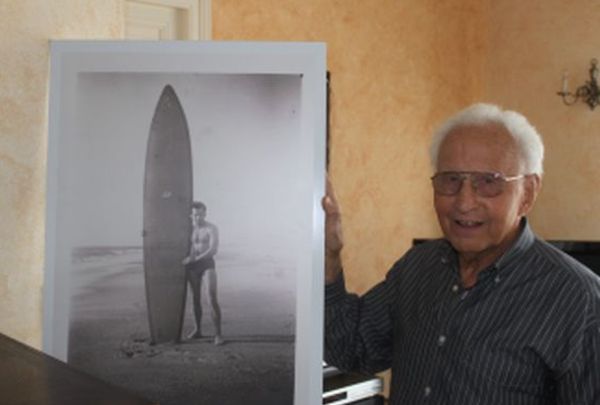
Photo courtesy of Philip Zibin.
Where do you come from?
Well, I come from Saint Pierre in the south of Reunion Island. My grandparents came from Montauban, not far away from here.
Ah! Montauban
I'm a bit from the South West.
And do you surf?
Yes, I do.
In Reunion Island?
Yes, on Reunion Island.
And you're not afraid of the sharks?
We deal with it.
They have showed all the safety nets are in place now.
They are very little use, it's just smoke and mirrors.
I don't have the idea to go surfing at dawn and even less at nightfall. I will not go when waters are murky.
Well, the best waves are when the waters are murky and it's
raining. The problem with Reunion island is its topological
configuration, you have river mouths, canyons and it is true this is
exactly where waves form and unfortunately the water is particularly
unclear. So, surfing in Reunion Island is a little bit dangerous due to
this history of sharks, but enthusiasts still surf. It's like cyclists,
even if there are car accidents, they continue.
It must be terrible anyway, being in the water, feet lurking
in the water, and instead captivated by the surf, by the wave coming.
At the beginning, this is the first 5 minutes.
After, you think less.
After, it's surfing, we are in the water.
You only feel euphoria and nothing else and not what lives in it.
Hey, when we are in the water, we see turtles, dolphins,
etc. But we are focused on our wave, focused on the swell, or we talk
with our pals. This is fairly standard. And, unfortunately, if tragedy did strike, we are only passing through this earth.
2. So, I wanted to know what was your first contact with the ocean? When was your first contact with the ocean?
Oh, my first contact with the ocean was when I was just a little boy.
Were you born on the coast?
I was born here in Dax, but I spent all my holidays at Biarritz,
because I had family who lived in Biarritz. Thus, Easter, Great Holidays,
even at Christmas, we went to the seaside, we didn't swim, but we were
in contact with the water [see Note 1].
For me, even if I don't swim in the ocean, I
love to contemplate it. It's so wonderful that we can stay in front of
a raging sea at "Rocher de la Vierge"and watch the waves splashing
during an afternoon without feeling the need to go into the water [see Note 2].
Absolutely, it's a big show. And before you were making plankies you were a carpenter if I understand correctly?
I was a cabinet maker and my father was also one. So, he taught me
how to do the job. At that time, we lived in downtown (Dax) but due to
the nature of our work with wood and the location of our shop we were
considered to be a high fire risk. Because if a fire started, all the
area around our shop could burn. My parents wanted to grow their
business, but each time, the mayor, banned the expansion and told us
"you should go away." So, they left.
And we came here in 1950, just after the end of the war. You must know
that I am two and a half kilometers from the town center, and at that
period, there were not many cars, no means of locomotion, people stayed
at home. Our business increased, so we decided to change our business
and do something else. Gradually as we did things, the business became
very successful.
And about this cabinetmaker activity, did it take all of your time? Did you still have some free time to be able to surf?
When I was making furniture, we had time. I like to be busy. My
time is 100 % full. After, we built a workshop. Life is funny,
orientations change. We made furniture for a gentleman who had
established a shoe factory here in Dax. That's how that started. This
gentleman came to see his furniture progress in my workshop, he saw
some pieces of wood on the floor and he always told me, with all these
sticks of wood that you throw away and put on the fire, you should make
me heels for my shoes.
We told him, wait a minute when we have made tons of heels for you, you
will get enough--when we finish a thousand pair of heels, you will
have enough. But he told us: "No, I need thousands of them every day".
After this revelation, I had an epiphany. We started making wooden
heels for shoes. At that time, I swam a lot and I did a lot of body
surfing. Body surfing was a special thing. Americans arrived in 1950,
and they had some particularly huge pillows.
Inflatables?
Yes, inflatables. They ran on the sand, with these inflated
pillows, sealed them, and they were going into the water on these kind
of sausages two or three guys on it. They were carried by the rolling
waves.
After that, they came with some air-mattresses. Saw them, surf with
these air-mattresses it gave me some ideas.
The planky arrived, very
quickly after. I think the planky appeared in 1947. That year we saw
the first plankies in Biarritz. I bought one right away and I started
surfing with this one. I had buddies who were lifeguards at the main
beach of Biarritz. They asked me: "Why don't you make plankies for us?
We can't find them and everybody wants one, so we can sell them for
you." So, with my brother André, we started to make plankies. We made our
first planky and our first prototype to mold the other plankies, with
this design, we could put them in the water and they do not delaminate.
We found an extraordinary marine lacquer, which doesn't exist anymore.
With this lacquer we could leave the plankies in the water as long as we
wanted. So, we would manufacture surfboards with that lacquer. That's
how we made the first plankies.
I brought them to my friends, the lifeguards, who have each taken one.
And actually through word of mouth, sold them to friends. And then one
day, I told myself, I will not limit myself to that, now that I've made
a prototype. I went to the shops (beach stores) in Biarritz, who had
difficulty finding them, and I sold them some plankies.
Okay, because there were not many manufacturers at the time?
No, there were very few producers. I'll tell you why we stopped,
one day, it turned out that some wood veneer manufacturers. By the way,
do you know what wood veneer is?
No, I guess it is—
It's plywood, wood which is made up of many wood scraps, you made planks and you can roll it out like that.
As you peel an apple.
As you peel an apple, but in the longitudinal direction, in the
direction of the wood fiber. You get wood veneers that are 2 mm, 1 mm
to 5 / 10th of a millimeter thickness [see Note 3]. So we had bought 2mm for our furniture and we had scraps of 2mm.
One day, a guy who is set to make wood veneer, it turned out that
he had scraps in huge quantities, something we did not. We had few.
And he began to make plankies. But it had such a costly price, that we
could not go on, so we said that we will not continue to bother with
that, we stopped it! And so we stopped production of plankies.
But who was that manufacturer?
I don't know, a manufacturer of wood veneer, he was not in the area, I
do not know where he came from. Besides, it was beechwood veneer, and
they left it the natural color of beech, usually they were a colorless
varnish, and it was sold that way. What they forgot to do as it was
delivered with a kind of glue, which were not waterproof glues. Us, we
had waterproof glues for furniture, and the plankies we were selling,
they couldn't delaminate because it doesn't dissolve with water. Three
quarters of the time plankies had, in the tip of the plankies there was a
wooden crossbar to prevent buckling, although it fell apart, it was not
efficient.
3. What was the origin of the famous nose curve?
Well at first the nose curve was made with steam, or a sort of steam. You could take a plank of white wood—white wood here it is poplar
wood—with which we make crates. It is a kind of timber that is
relatively light, which is soft enough, and which bends relatively
easily by steam. So we lowered the timber in boiling water, soaked it
and then left, it was enough to make a counter form of what we wanted
and we slightly bowed it and "Plaf" we left it to dry overnight, the
next morning when the water was evaporated, the curve was more or less
set.
After we tried real steam, because we have done all these tests, we
tried steam, the steam was really a steam engine, and it was a real
mess. We thought we will do the same as for furniture, ogee doors, we
made curved doors like that, we will make a matrix, we'll make a frame,
and we will mold the stuff with the nose curved. So where did the idea
for the curved nose come from? I have no idea, there's a thing, it is
the air mattress, which the americans had arrived with, the mattress
was fixed and you had the headrest which was slightly bent like that.
And when they wanted to catch a wave, they lifted the headrest. Did it
come from that, I don't know. But there's one thing we know, when a
wave breaks, it has a relatively steep angle, when it breaks this
steepening occurs, and if there is something very flat, it will pearl.
On top of that, the skis, they are all bent at the front. Progress has
been made in downhill skis, now they are less curved than before. But
at that time the skis, they were very curved, so I think this is logic
from that. That's the logic why a planky is shaped to have nose curve.
So in the beginning in the 1920s, we saw
what might be called the ancestor of the planky but completely flat? (I
am referring to the early English surfing planks known as coffin lids.)
Because it exists since the 1920s?
Coffin Lids at Perranporth, Cornwall, UK, ca. 1919
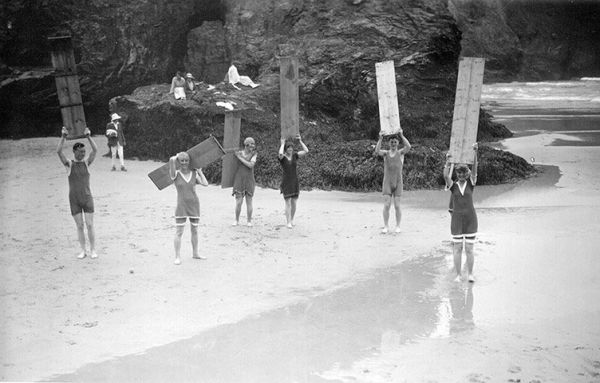
Photo source unknown.
Before that! I have some information, now it is to be
verified, it seems that in 1925, Georges Hennebutte developed a
surfboard, maybe curved or not. One of his nephews is Claude Durducoy.
Have you seen Claude?
No I haven't seen him!
I called him last night to know, to avoid telling nonsense, if he
could remember the time when we first saw them appear? So together we
have located them in the year 1947. And then I said, "George, what did he
do?" He told me this story where he went to the store "Au Bonheur" ("To
Happiness") in Biarritz, to retrieve what textile was packed with.
Well, fabric is rolled around flat boards. Then he would retrieve
these boards, from clothier merchants, these boards, he would have
bent, soaking them in hot water and put a counterweight to give a shape
to it. The disadvantage is that it was not long lasting.
Ahh, he tried.
It's normal he tried. Anyway, he was a boy who tried everything.
Yes, he made many innovations.
Absolutely.
Henri Poncini With a Planky, ca. 1958 (left) and a Curved Nose Planky (right)
|
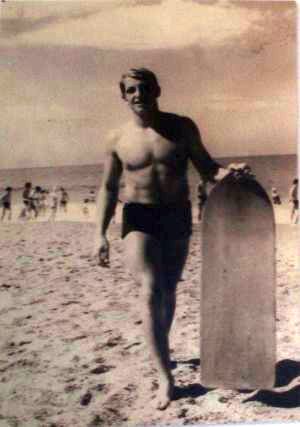
|
|
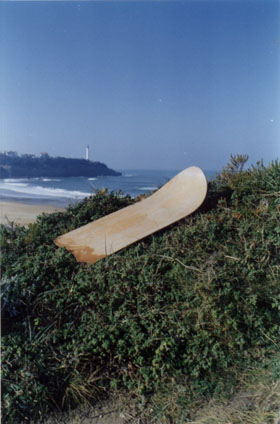
|
Photo from the 2007 Anglet exhibition courtesy of Antony 'Yep' Colas and FreeWave website.
Planky
|
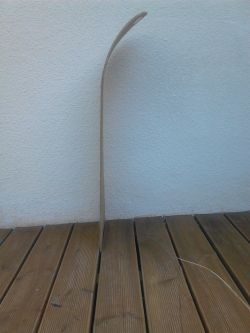
|
|
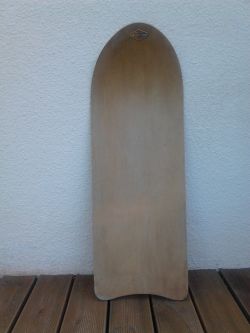
|
Photo by Hervé Manificat.
4. And can you talk to me a little more about George Hennebutte?
Georges Hennebutte
|

|
|
Yes, this is beyond the scope of planky, I knew Mr. Hennebutte by
accident. I made my first surfboard in 1952, after a movie I had seen
about the commemoration of the attack on Pearl Harbor, it was in
December. The attack was in December 1941, it was the 10 years
anniversary, so it was in 1951. On the theatre news, I saw the attack
on Pearl Harbor and I saw the Americans enjoyed themselves with all
sorts of games. Suddenly a flash! A guy was standing on a board; in the
meantime we did the planky, we were prone. I was with my brother, André. When
we saw that, we jumped on the seat, and we said, "We can do that
standing up, it is fabulous!!!!" I could not see the shape of the board. After that, I made a board in 1952. We
started to work with white wood panels, poplar, to do a surfboard. We
said that to be buoyant, it has to be big enough, we will make a length
of 2m20 long, besides the boards (poplar) were not much longer. And we
made the nose curve; we said that we will make a curved tip, as we have
for skiing, and as is done for planky. Here's how by deduction we
figured it out. It was a square box. We made it simple. There was no
skeg, nothing. |
Photo courtesy of Antony 'Yep' Colas. |
And then I went to try it at Biarritz, a total failure, I tried it at
the "Chambre d'Amour" in the morning and at Ilbarritz in the
afternoon with life saver buddies, we ended up in the rocks, the board
was broken in half, it had a hole. The panel, as it was not plywood, has
cracked, water filled inside. We surfed again, the guy was at that time
a friend who was on the board, waiting, during that time the board was
filling with water, and then when the wave came, the surfboard is set
like this, all the water that was inside passed to the front, then he
caught the wave, he pearls like a submarine, he wiped out, the board
went up in the air and "boom", it hit his head. "What the fuck?" The
board finished on the shore broken.
This adventure lasted for one day. So that was in 1952. I did not renew
the 1952 experience, and in the meantime I saw "Hawaii, Dream Island"
of Jacques Chegaray. I went after the conference he was a young brat at the time, he gently rebuffed me [see Note 4]. I couldn't get
anything from him. I asked him technical information, nothing. So I
left, but I had seen enough, to get an idea of the stuff. That was in
the autumn of 1952. In 1953, I was called to the army for my military
service, so I went into the army, March 1953, I stayed 18 months in the
army, and I went back in December. Because when I went to the army, I
came back and was recalled the next year to Algeria, from Algeria I
came back at the end of 1956.
Meanwhile, this summer 1956, Viertel came to Biarritz with a surfboard.
He made a film with Hemingway, and came to see the waves of the Basque
coast, and he said: "We might be able to do some surfing there". You
should know that Viertel did not know how to surf. It was Zanuck who
knew surfing, not him. So, he dispatched a surfboard from California,
and tried to stand up, he failed, he did not know he had to put wax on
it, he wiped out. The board finished in the blocks, the nose of his
board broke, and had to be repaired. And Hennebutte was there!
Hennebutte repaired this board, he had just started to work with
polyester. He repaired the nose of the board, and when it was repaired,
he wanted to try again with Viertel. So they did not know surfing,
neither one nor the other, they were not able to stand up, and they
gave up.
And I, when I returned in December 1956. Biarritz buddies told me,
"Jacky, there is an American who came with a surfboard, a real one, and
he left it with Hennebutte in Biarritz "
I didn't know Hennebutte. So I called him and I told him who I was, and
I asked him could I come up and copy this board to make one?
He said, with pleasure, come. I went, I met him, really charming. He
left me to do everything that I wanted to do. So I took the board
dimensions, rough curves. And I immediately ordered balsa, in Paris, I
had a supplier named Henry Caumes, and he brought his balsa from Peru,
I believe. Unfortunately I did not have big planks, but small beams,
which needed to be joined. So, the beams were not very thick.
More like model airplanes, something like that?
Yes, these small pieces of
balsa were intended for model airplanes model, not for surfboards. The
company was mentioned as a balsa retailer [see Note 5]. But I did not know how thick it was. I thought he
was going to send me a beautiful beam. He sent me beams that are 80mm
thick. In 80mm thicknesses, to get the rocker to the front and rear, I
did not have much way to work with.
And so I made two boards. When I say "I" it's us, because I did
everything with my brother. We made two boards. These two boards, when
they were finished, we had to seal them. I didn't know about polyester,
I just knew the polyester lacquers, which I used for plankies. But I
remembered we had a friend who was shoe manufacturer in Saint Paul,
named Josée Doyoresti, a family from Biarritz, some of whom lived in
California. So he told me, every time he came for heels, you know,
that's fine, but you'll slip. You should put wax on it and underneath
they put silicone to make it slide more easily. It's called, I always
remember the name, "Carplate." Underneath they sprayed Carplate and above they
put wax on the deck.
But I told him: "Wait! Wax on a surfboard! I put it under my skis to go
faster, I didn't see myself putting some wax on my surfboard, I will
wipeout" Here's the story. So, meeting with Hennebutte happened just
like that. I went to his home, he let me copy the board, and I made two
surfboards. I put them in the water just after summer of 1957. That's how,
I knew Hennebutte.
It's a beautiful story.
5. There were other manufacturers in Spain, like Marcelo Linazasoro, who
was a carpenter in San Sebastian. I have some pictures to show you how
he made his boards. I think it is almost the same process as you do.
There was a mold, here is what remains and the result.
Yes, he puts his wood veneer there, then it's a two, three plys. 3
plies
mean nothing; we need 5 plies. If you want it strong, it must takes 5
plies. And with the press you compress it all, and you unmold when the
glue is dry. In addition, it had a curved tail, I saw plankies with the
tail curved. I made some of them like that, but I stopped quickly
because it does not add anything, this one I've never seen (first one
on the left). It was much larger like this I think, yes like that. I
have the first one that was used to make the frame, which is below.
Marcelo Linazasoro Egaña's Planky (Basque Txampero) Press (left) and Spanish Planky with Curved Tail (right)
|
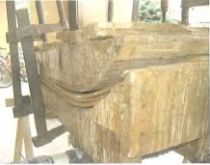
|
|
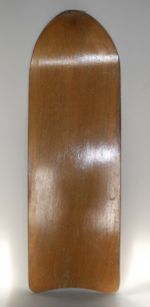
|
Photo
from the publication, Lázaro Echegaray Eizaguirre and Mikel Troitiño Berasategi (2007).
What the waves brought in: a history of surfing in Zarautz. Zarautz:
Ayuntamiento de Zarautz, Departamento de Cultura. On the above right a
photo by Gavin Randall of Traditional Surfing company, UK.
I would love to take pictures while we go.
I'll show them, and I have one that I made the planky with (blue
one). I brought them back from Biarritz this winter. But the first one,
it is raw wood, it is all dirty, she suffered all the ravages of time.
Jacky Rott With His Blue Planky and the Board Used as a Mold
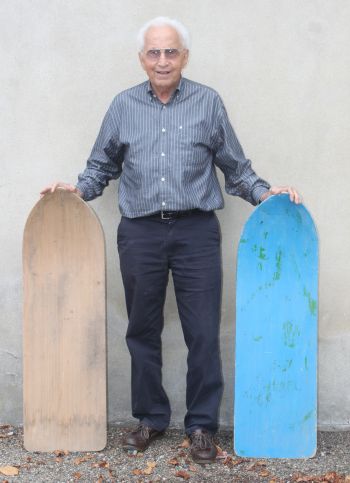
Photo courtesy of Philip Zibin.
And on your boards, do you have a logo, a brand?
Not on the first boards that I made. I called them "Neptune."
Yes, it's for surfboards.
On plankies, nothing. No, there was nothing. My brother reminded me
of a story about that. Because I thought the board was a little "nude."
And we were after the war, there were pin-ups. I had decals with a
pin-up, and I put them on the boards. The boys in Biarritz were very
happy to have a pin-up on it, they were not naked.
I know, that's what was on warplanes.
Well, pin-up of the post-war. One day, I arrived in a shop to sell
my "pin-ups", they told me, we do not want this "thing." I should sell
completely plain boards with no pin-ups.
Do you know, how many boards you crafted? Per day?
I do not know, it was done in my spare time. How many was I doing? I don't know.
The approximate volume?
I don't know exactly. Around twenty a day.
Were you doing rental too?
No, I was just into manufacturing and they were delivered to stores, we couldn't do it all.
It seems that Sosthène Larcebeau from Bayonne also was making plankies. Can you tell me more about him and the boards he made?
No,I never met him, I lived in Dax and we were not many.
Who else were making plankies?
There was few at the time, but I don't remember.
6. Jacky commenced talking about riding and making surfboards.
I
haven't told you how I used wax, you remember my first attempts in
1954, I didn't know I needed some wax on my surfboard. My mother made
some jam, I stole some wax from her, I put this wax on, which allowed
me to stand up. And after that, I was associated with Barland, we also
manufactured bars of wax. I still have one or two bars of this wax
somewhere.
A collector!
Yes, yes I preciously kept it. Now, I can show you a picture of me
before returning to Biarritz in 1957, after the failure of 1952.
Because of the failure of 1952, it was with all my friends who were
life guards in Biarritz, they remembered, they still remember, those
who are still alive. So they knew I built surfboards similar to
Viertel's model. But I thought to myself, the Viertel model, I have to
test it on the "Landes" shores, where there is nobody. So like that,
when I'm back in Biarritz I will not be ridiculous again.
So, what I did one evening, it was in May, around that time, it was
not warm, and it was stormy. They had finished our surfboards and we
went to pick them up. I have not talked to you about the sealing of the
boards, as I didn't have any idea what we needed.
There was a gentleman in Uza, who had begun to use polyester resin. It
was the "forges of Uza", which belonged to the "Marquis Lur-Saluces,"
who was the owner of "Château Yquem" [see Note 6].
He started up this thing. I went to see the director of the factory and
asked him if he can laminate these boards. He told me: "No problem, we
can do it."
So I left them with him. I arrived at the factory with finished
boards, which had a net weight of just under 15 kg, due to the kind of
balsa that I had. When I came back to get them, with my brother, they
were beams, the boards weighed 30 kg. They had absorbed the resin.
He had forgotten, or he did not really know what balsa was. When I arrived, I was shocked, "how come they got such weight"?
Ahh, well, the workers, every time they glass the resin was absorbed and "Poof!" so they glass until it was no longer absorbed.
So they saturated the cloth and it finished at this huge weight. It
was a transatlantic liner style board. It could have stormed, with the
weight they had, they would not move. And so it may be that, surely,
that allowed me to be able to stand up on the first try, standing
steady, because the board does not move, it was very wide and very
long, 3 meters 40 centimeters. I will show you the photo because I don't have
the board now.
So I'm going to try one of these boards with my brother, my father and
my mother, one evening in Hossegor at "l'epi nord", where today the
world championship occurs between "la graviere" and "l'epi". We went
there. There wasn't a soul on the beach, nobody, absolutely nobody! So,
I am going in the water there. And as I was body surfing and doing
planky, that's where I was going. I knew that there were waves, so I
went directly to that location.
I took this first wave, I was the happiest man, and I said while going
out, "right now I can go to Biarritz, it works".
Because, all the guys who come and see me, they all told me, "You're
crazy, it'll never work." I had the father of a friend who was not an
engineer, but almost, who told me it cannot work making a demonstration
on a blackboard, "The waves of the Pacific have this shape. As the
waves of the Atlantic, they have this other shape. So you cannot! It'll
never work your thing!" I proved the opposite.
I waited until June when it warms a bit, because we surfed without
wetsuits. So one Sunday, I went to Biarritz, I went to the "Cote des
Basques, near the Belza Villa. I went surfing there for the first time.
After that, I went to "la grande plage" beach, I surfed it on all the
beaches of Biarritz. And after that, my friends saw what I had done. I
had two boards, one, which was for me, I always used. The other one, I
lent to other buddies. And when I came out of the water, they waited
until I finished, they asked me for my board, I lent it and they went
surfing with it. At the end, inevitably, "you make me one". That's how
it began.
French Planky
|
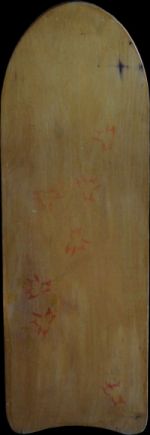
|
|
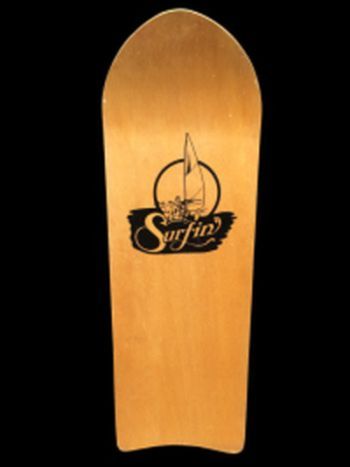
|
Photos courtesy of Gérard Decoster.
7. What is the influence for you of plankies on surfing in France?
The
influence that it had on people like me? Because everyone has seen the
planky, some saw it before me, people like Hennebutte saw it before me.
It did not give us the idea that we will make a longer board to stand
up on.
The movie I saw in 1951, this sequence of the bombing at Pearl Harbor.
I'm not the only one who saw it, it was in the news, do not ask me the
title of the film, I don't remember. So it reminds me of that day that
I saw a guy standing on a board. I thought, "Gee,"
is what remained marked in my memory. So, a lot of people have seen it,
but nobody had the idea and the passion to realize it, that's all. [See Note 7.]
It has been a realization. I loved to go to the beach and I loved
everything that makes me glide. Skiing is the same, I was all the time
doing that. As soon as I had a weekend, well, I went skiing, I adored
it. I love skiing. So the first time I glided with a surfboard there was
this an unspeakable happiness.
When you catch a wave at the peak, it's the silence, we heard nothing,
the waves took us and I did not do anything compared to the boys today.
In the beginning I glided straight and then I started to turn and go
across. and all that, it was a long process.
And I'll always remember, a meeting was organized to rescue the great
beach of Biarritz. And so there was Viertel's board, my two surfboards,
and there was the Australian team there. We are truly beginners
compared to them. And then, they asked us for our boards, I lent them
my boards. Then, they went to the water and I will always remember,
there was one person who went into the water with the red surfboard I
had, not this one [photo above], he goes far out suddenly, in front of
him arrived rolling waves. I said to myself, "he's not turning his
board, he never turned back the board to catch the wave, he just spun
his body on the board and caught the wave fin first. The fin was out of
water and as the tail was a little pointed, he started to surf, and he
used the nose of the board as a skeg, with the fin still out of water,
and we all looked, and saw we had room for improvement. We had no words
to describe what we saw. We did not believe it.
They have a history of surfing, much older, they had experience.
In fact, when we arrived in 1961, at the world championship over
there [Perú], different people who came from different countries, different
continents and all the surfers of the planet. Pouffff !! We learned
more there than anywhere else because we saw things that we were not
used to seeing. [See Note 8.]
Jacky Rott (fifth from right) at 1962 Peru International Surfing Championships
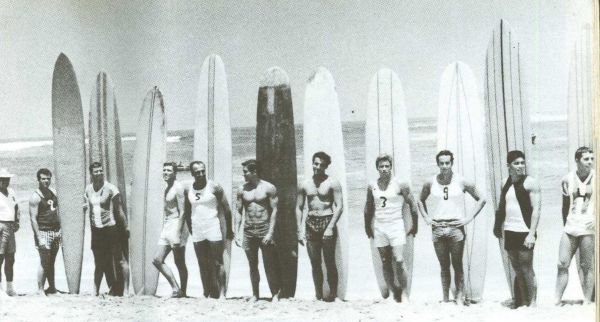
Wiese, Guillermo. Playa de Kon-Tiki, Waikiki Surf Club Magazine, pages 26-27.
Yes Peruvians were already good.
Yes, they were already good, and there were the Californians and
—
— the Australians.
Yes, the big stars of the era were there, the
South Africans were there also. But me, what I will always remember is
that at the beginning of surfing here we very quickly found a group of
ten.
And surf trips, we phoned on Saturday, we found ourselves at a certain
time at one beach or another, and we all left there on safari with
the boards on the car. We went to La Barre, Guéthary all the spots
that had been discovered on the Basque coast. We surfed as a clan, as a
team of friends. I will always remember Guethary, from 3 on the wave,
with the strong desire to surf 3 on the wave, crossover each other on
the same wave.Today, if you did something like that, you would get
killed: "You stole my wave!" Wait, it's finishes in a fight—it's
not possible—I have not experienced that fortunately.
Pictured Below Are the Original French Surfers, the "Group of Ten," Known Popularly as The TonTons*
|

* See Note 9 for the origins of the term TonTons.
|
|
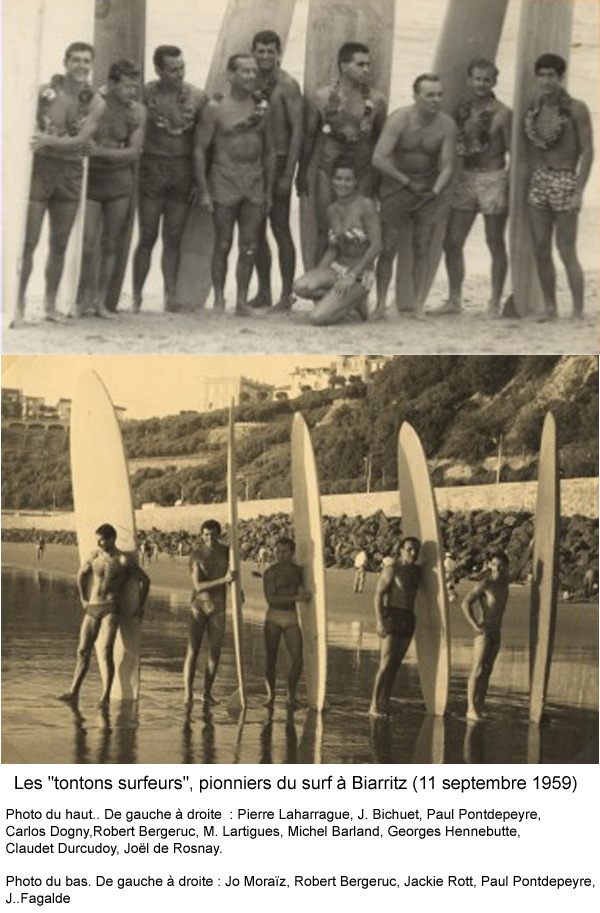
|
Photos from 'Les origines du Surf' by "Carrefour du Futur."
Jacky Rott and Fellow Surfers, Cotes des Basques, ca. 1957
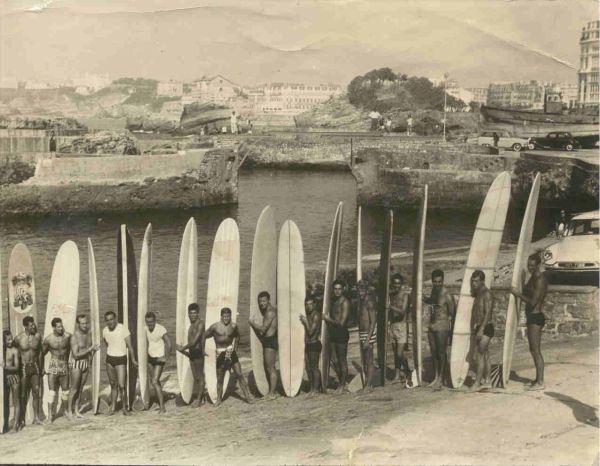
Photo by Joël de Rosnay, courtesy of Antony 'Yep' Colas.
It's another kind of mentality, indeed.
I confess that surfing it has been for me something extraordinary in my life.
I have known skiing—skiing the joy I experienced surfing—but
I think I had more feelings in surfing than I had skiing. Skiing is one
thing, I loved the powder, however I don't like the packed snow when
the track is already made, it is a little bit like when we glide on a
wave. The top of the mountain is there, we choose a track, and the
mountains, they do not move unless there is an avalanche, of course.
When in the water, it is the avalanche, and it is behind you, and it
only wants one thing and that is to catch you. And sometimes, when it
closes out, you must kick out, you must get out in time, and there is
another feeling. It is much more intense than skiing. Much more. I
think, free riders must be really scared, but I think they are crazy.
The physical ability is similar between them but I feel surfing is more frightening.
Yes, especially now, people surf anything, anywhere.
8. I have a few stories, and wanted to know if you have heard about them?
There was Justin Hiriart (un maire de Sare) who would have gone to
Hawaii in 1912.
In 1912?
Yes that's the information I had. And he made a kind of planky from a wine barrel. Have you ever heard about that?
I'll tell you that we hear everything, and my answer to that one
thing is very simple. Now I do not know why, moreover, everybody wants
to know who was the first. We cannot know it, I know what I did, I do
not pretend. I invented nothing—I merely copied. But one thing I
notice is that before what I did, given what I've seen, I hadn't seen
anything else in France.
So now, I hear about a board that was built by
someone in Biarritz, but I have never seen them! But from the time I
was seen on a board in Biarritz, I can tell you immediately that there
were imitators who started to manufacture some surfboards.
Michel Barland, who became my associate, he saw me in the water, he
asked me: "What is that thing there? Where did you get it?" I told him,
the model of this surfboard is in Hennebutte's home. I told him the
same thing. He went to Hennebutte, and he did what I did, he came to
measure the side of the Viertel board, in 1957, and because he was a
mechanical engineer and had a big mechanical workshop in Biarritz he
began to manufacture surfboards. He made them hollow and he sealed them
by covering them with wax clothe. And then one day, I happened to see
Michel Barland with a surfboard, hollow, with wax clothe and it worked
great and it floated. A few days later I see a guy from Orthez, Bruno
Reinhardt. Bruno was the director of Bearn Orthez, a wood factory that
created seats.
So there was plenty of wood available and he had an idea
for a surfboard. The top was made of plywood which was screwed onto two
chords of wood that made a frame. So we were all there. I said: "Wait a
minute, your board is varnished but it will not work." He asked me why.
I answered him: "It will fill with water, you have not put in a drain
plug. You need to put in drain plugs, because when you come in it will
be full of water." He said to me: "It is not possible, I used Caurite
that I made my plankies with." I said to him: "You have to glue Caurite,
but you used screws, they make holes, and the water it will get through
the holes by the thread of the screw." Sure enough, when he came out,
it was full of water. At first, he caught some waves, but it was like a
submarine after. He returned the following Sunday with two holes on the
back and two drain plugs. Whenever he went out for an hour of surfing,
he undid the cap and emptied the thing.
From the first time I saw a Viertel board, I immediately made one. I
continued to make more boards after that. The boards that I made and
the boards that Barland made, we made on our own at our own private
shops. And it was only after—I do not know how many years—two,
three years—we associated to try to faster advance techniques. We were
visited by chemical engineers from Rhone Poulenc and Saint-Gobain, they
made Barland do the same stupid things they did with me [see Note 10].
This caused us to make the same mistakes on our boards. So we said, we
cannot continue like this, we will work together to advance the model
and this is how we became associates.
The association was made on the
water, in the water, we said we were partners, tape in hand (high
five), and we never signed any paper. We stayed like that associated
for some years. We did the boat shows together, and then one day I got
fed up, for different reasons that I can't explain, so I told Michael,
I quit. You continue to manufacture boards, all I ask is that for a
while you leave the brand as Barland / Rott, and should the day arrive
that I would like a board, you would make it for me. This is where I
stopped. Done!
Jacky Rott, ca. 2015, at Vintage Surf Meet, in Hossegor, France (left) and Barland-Rott Surfboards (right)
|
Photos by Jean-Pierre Guedon. See Jean-Pierre Guedon blog.
Photos by Jean-Pierre Guedon.
I stopped surfing, as I stopped the planky manufacturing. I had other
things to care for. I had other activities, which were more profitable
than this, because making the boards did not provide enough extra
money. Fortunately, I had a company that allowed myself to live. And
for Barland it was a metallurgical activity, but it cost too much money
to continue making the boards. If we had not had other businesses we
couldn't live. After we stopped making boards there were still people
in our lives that continued this craft. My friend, Pierrot Alarague, he
made a board in his basement, it remained in his basement, it didn't
work, it didn't hold. After, I received phone calls from guys from
Hossegor, from everywhere. They wanted to ask me how to make surfboards.
It creates a tendency for confusion, that's what I tell myself
about these stories, there are plenty, and never based in fact. We did
not see them.
They were stories told by others.
I think that when you have a passion, it goes to the end, otherwise it is not a passion.
Hennebutte, he had a passion, it was alive until the end. He had
different passions and he never quit any of them, he would make
mistakes but he would learn from them, start over or correct and keep
going. He never gave up on anything. Even when he was told, it will not
work, you're gonna drown, or something—precisely with the Swordfish
crossing the Etel bar [see Note 11].
Even in the beginning when they were forbidden by the prefecture to
have the wood workshop in the town, he didn't let that stop him. Well,
just like myself, I saw something I liked that interested me and I
began to make a copy for me to use and I did not let my failures in
1952 stop me. I continued.
The purpose of this research is to see how the French planky you saw in 1947 influenced your planky design.
We were discussing (with Durducoy) last night: we first saw
the planky in 1947, because in 1945 it was the liberation, during the
war we did not see them.
It was forbidden to swim I guess?
We couldn't in France, therefore, in 1945, the first people who
glided on the water were the people from the U.S. in Biarritz with their
pillows and air mattresses.
This was the first time, I saw people gliding on the water like that. We used our bodies only, no flippers or fins.
And before the war, there was something? People went surfing?
No, I have never seen plankies, nothing at all, ever, ever.
Some people said that in Biarritz, planky was practiced. I think there
might be photos somewhere. I think we would have heard about it. And I
also think that we would not be left with such a long period, without
the development of a few things. I tell you that in 1952, if I had not
gone to the army. I would have made a real surfboard after seeing the
film "Hawaii Islands Dreams" of Jacques Chegaray, because it was in
this film that I saw the profile of the surfboard, although I had not
touched it with my bare hands, I saw it. So I would have ordered the
balsa and made it then, but I had to wait until 1957 after leaving the
Army.
So all these people talking, talking, I let them talk. As I told them,
we can go much further, I am convinced that one day, Leonardo da Vinci
designed a surfboard.
9. It is possible, it has not yet been found. He had to think
about it anyway. He was a genius with great ideas. We talked about all
the questions around the planky, we want to and clarify the history of
the planky. Especially the French planky. In England there are
pictures, journals, it was practiced in the 1930s. But not this curved
shape that is specific to France. They were flat boards (I made a
mistake, they were slightly curved). People pushed on the back to avoid
pearling.
They held the surfboards themselves?
Yes, They held the planky firmly and it was on the Cornish coast beaches, they pushed their feet on the sand to catch waves.
Ahh, they were pushing with their feet, then it's possible to catch waves.
They were pushing off the bottom with the feet, and then
they would glide on the roller, on the broken wave, up to shore. So it
was done in the 1930s and it was thought that as the British
Royal family spent many holidays on Biarritz, perhaps it was an English
import in the 1920s or 1930s.
Surfers Catching Waves by Pushing Off the Bottom With Their Feet ca. 1947
|
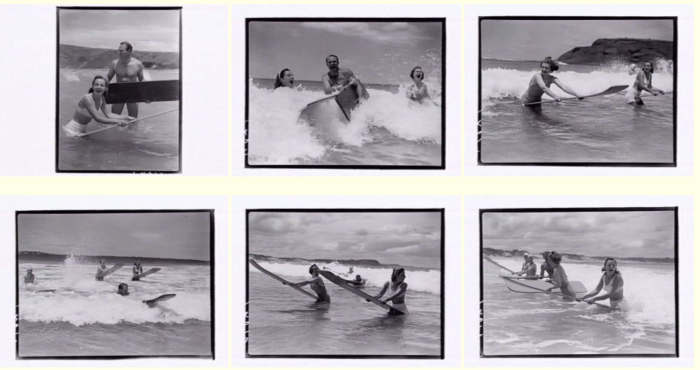
Photos courtesy of the State Library of Victoria. Surfing, Summerland Beach, Phillip Island. Victorian Railways.
|
There, I confess frankly, I was born in 1932. Between 1932 and 1935,
I was little and I have no memory of such things. I remember when we
went to Biarritz, we would pick up shrimp and crabs, did not look too
much at what was happening in the water. And I have no recollection,
and my swimmer friends, we talk sometimes. We have no recollection of
having seen people gliding on the water. Me, I was not there every day
in Biarritz, but they were there every day, there were lifeguards
watching the beaches. There is no one who has been able to give me a
story of this nature. None.
(Below right) Unknown Surfers at Biarritz With Planky (ca. late-1920s to early-1930s) [See Note 12]
(Below left) LEC Planky, Undated, Measuring 1m x 0.36m, Possibly From the Town of Royan, France
|
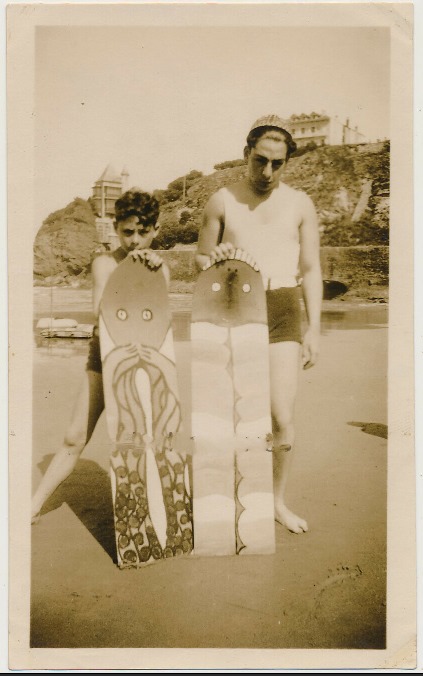 |
|
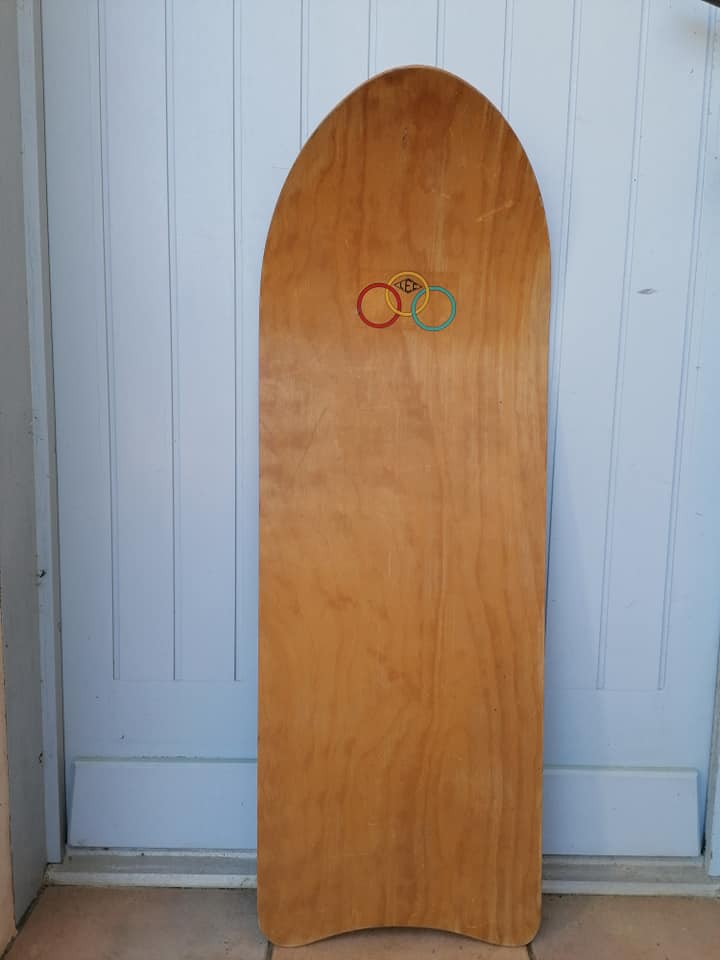 |
Photos courtesy of Charles Upton (left) and Fred Ureta (right).
Two Questions for the Readers:
(1) We understand that a planky competition was held in France around
the year 1950. Please contact us with any information you might have
concerning this competion. email: The
Paipo Interviews | paipodude@mypaipoboards.org
(2) What is the meaning of the letters LEC? email: The
Paipo Interviews | paipodude@mypaipoboards.org
10. That's what we try to clarify. There is a lot of
information, but it is questionable, because we have no documents.
There may have been actual individuals trying, who did not go further
or abandoned it for unknown reasons. Like manufacturing a board with
the remains of a wooden barrel, nothing remains.
No, a barrel stave, it is curved over its entire length. There is
no flat portion. The only advantage they have is that it keeps the
curve, but it is oak and it's thick, it's heavy. The oak is very heavy.
While for floating, we look for wood that is very lightweight.
I remember some pictures. All of my friends, they laughed at me,
because I remember the first time I arrived in Biarritz with a board. I
carried it over my head because it was too heavy, 25kg, 30kg and 35kg
at the end of the season when it absorbed a little water. They were
beaten up, there was no leash, they went onto the rocks, and the balsa
absorbed water. It was not until at the end of the season that it would
dry. And everyone made fun of me, mostly, "what is that that thing? ","
You think this is the Hawaian islands," This and that.
Yes—the sceptics—there are a lot.
Yes, there were a lot of skeptics. "It will never work your thing" and
"Never, it will not work." And then when I see the mass of surfers
across the Atlantic coastline across Europe. Who surf both sides, and
"it will not work."
My brother often tells me, there is one thing that we have not, I have
not seen, the commercial side of surfing. We used surfboards, that were
sold everywhere, but it wasn't a lot of sales. Surfing was slow to
develop in the beginning but with the Hennebute's invention, the famous
"fils a la patte," [see Note 13] it allowed surfing to become more popular. I talk about it all the
time, the French invention, and it happened a few years later in the
United States, they called it the Leash. Sophisticated and now it's
everywhere.
And here I am at fault, while we were in Biarritz, the group that we
were in, we made fun of him. Because the rubber he was using was very
stiff. It was a kind of like a bungee cord but it was only long enough
to wrap around our ankle, there was no extra length. And I told
Durcudoy, who was his guinea pig. "But Claude, you come from Guéthary
with that, if you have a wave that breaks on you, and you have no extra
leash then it will pull out your poor leg with the board because there
is not enough elasticity in the rope."
As a mountaineer with too tight of a rope.
Exactly, we did not want it, they said it will not work your thing. And
the poor boy, instead of taking an international patent, he took a
French patent [see Note 14].
It remained as a French patent, I do not know if he had the means to
defend a world patent, a world patent, it is expensive, and the search
for previous similar inventions is expensive, you see what I mean,
the guy who invented the bungee cord, might have sued him, even if it
wasn't primarily intended for that use as a surfboard leash.
But thanks to this application surfing is accessible to everyone, like
the ski tow for skiing. Because at the time we were more of a swimmer
than we were a surfer, because if we fell off, we would have to swim
back in and our boards would reach the beach before us. And often on
the Basque coast, there were blocks and rocks so we had some boys that
would pick up our boards before they could hit the rocks. They could
take the boards out for a few waves while we swam in. After we reached
the beach they would give us our boards back. Hennebutte's is the real
invention. His "fils a la patte" was great, but it now also creates the
problem of having too many surfer's in the water at one time.
11. Well we have arrived at the end of this interview. I
would like to thank you for the time we have spent together and for all
precious insights and information you shared with me. So, please let's
see your famous plankies in the shed. I will take a few pics of them
with you.
Barland-Rott Fin Logo
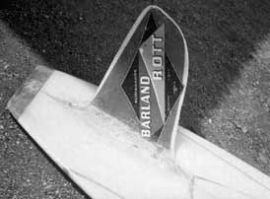
Photo by Guilhem Rainfray.
A French Surfing Hero Is Honored
|
 |
|
|
On
July 10, 2018, Jacky Rott Was Alongside Champions Joel De Rosnay,
Pauline Ado, Tom Curren, Maritxu Darrigrand, and Nat Young to Leave His
Footprints on Surf Avenue, in Anglet, France |
|
|
Rest in Peace, Jacky Rott
(August 27, 1932 - June 7, 2019, age 87)
Tributes to Jacky are posted below, with a link to the original French website and a downloadable translated version
The City of Anglet, France, Honored Jacky Rott With the Imprint of His Feet on Surf Avenue
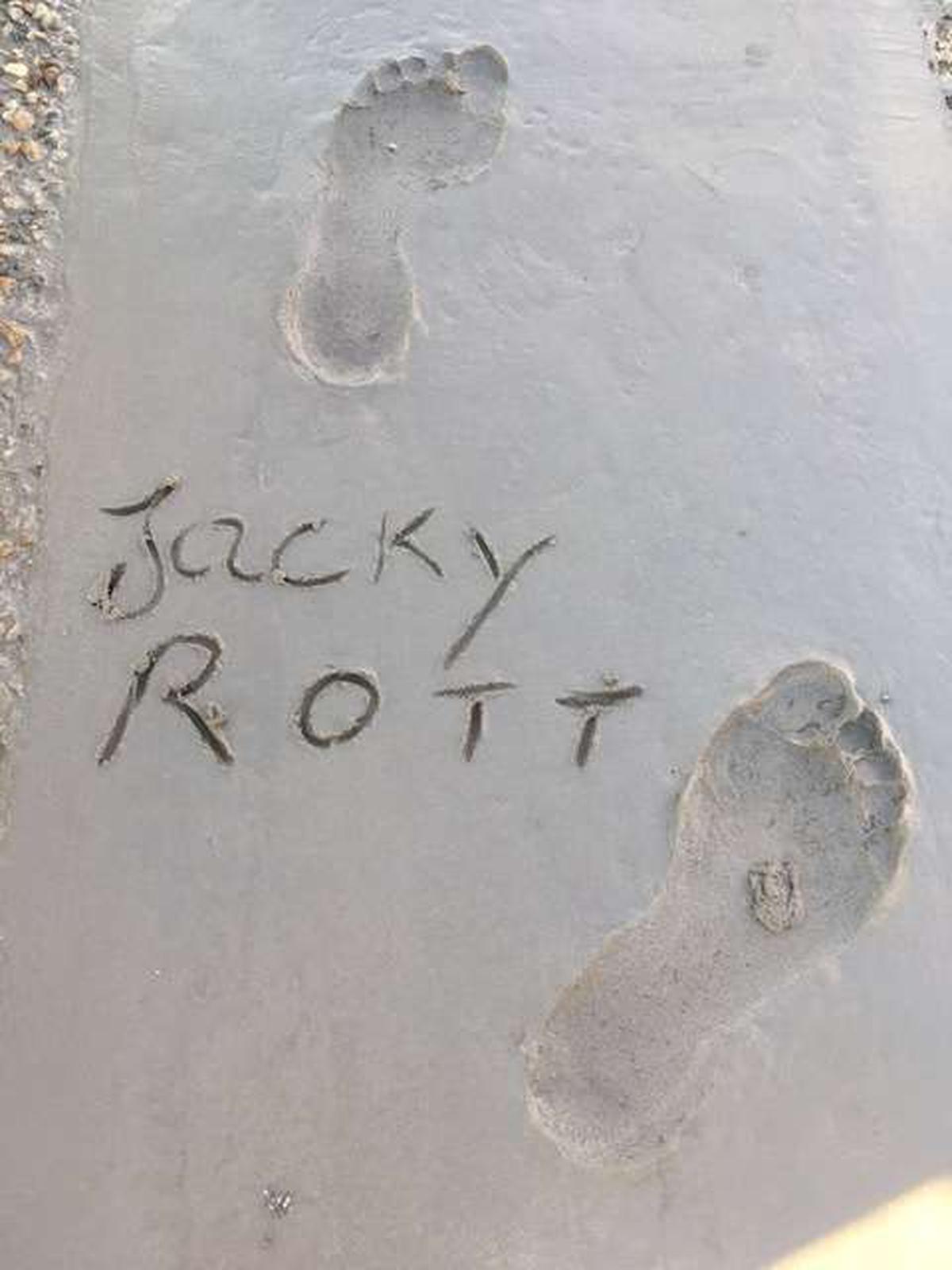
Source: Servaire, Olivier. (2019, June 8). Tribute to Jacky Rott, pioneer of French surfing. Surf Session (website). French Surfing Hall of Fame
Notes:
Note 1:
Grand holidays are the Summer time, July to August.
Note 2:
A place in Biarritz, on the seaside, where a statue of the Virgin Mary stands.
Note 3:
See Construction of veneer sheet
Note 4:
In French, a conference is a presentation (Q and A session) by a director after a film showing. In 1957, Jacques Chegaray published a book by a similar title, Hawaii: Isles of dreams.
Note 5:
In one of the French industry directory books.
Note 6:
Famous white sweet wine brand.
Note 7:
In the French the word "tilt” was used. Tilt is the sound made by a
pinball machine or when you switch on a light bulb, meaning I have an
idea. The Greeks said “eureka.”
Note 8: In
the early-1960s "the Makaha International was the unofficial but
generally recognized venue for international competition. It had been
running since 1954. The 1962 Peru International was attended by teams
from California, Hawai‘i, Australia, France, as well as Peru. Surfer,
film maker and magazine editor John Severson later wrote that, in his
estimation, the 1962 Peru International was “the first successful event
where teams from most of the leading surfing areas of the world were
represented.” The first widely recognized World Surfing Championship
contest in Peru was in 1965. Source: Malcolm Gault-Williams. (2021). Legendary Surfers: Early History of Peruvian Surfing. Retrieved 2021, May 18, from http://www.legendarysurfers.com/2016/07/early-history-of-peruvian-surfing.html.
Note 9:
The Tonton surfers of Biarritz. Tonton translated means "uncle."
http://www.thebottomturn.fr/news/1318-l-histoire-des-tontons-surfeurs-bia.html
For a French book: (Source: Gardinier, Alain. 2004. Les tontons
surfeurs: Aux sources du surf français. Anglet, France: Atlantica)
The tontons surfers included: Michel Barland, Jacky Rott, Georges
Hennebutte, Henri Etchepare, Jean Brana, Claude Durcudoy, Jo Moraïz,
Joël De Rosnay, Arnaud De Rosnay, Bruno Reinhardt, Alain Bégué, Jean
Brana, B Pierre Laharrague, André Plumcocq, Paul Pondepeyre, Robert
Bergeruc, M. Lartigues, J. Fagalde and Carlos Dogny.
Note 10:
Chemical process, product dosage.
Note 11:
See The Swordfish crossing the Etel Bar
The inventive Georges Hennebutte (1912-1974) who amongst other things
was a sculptor, designer of the Swordfish (the l’Espadon, an inflatable
boat), a surf leash, life saving devices and many other inventions and
is credited with developing the distinctive ski-lift nose of the planky
(Source: Gardinier, Alain. 2004. Les tontons surfeurs: Aux sources du
surf français. Anglet, France: Atlantica)
Note 12: Regarding the
dating of the photograph the Museum told us in an e-mail of March 29,
2021 (Google Translate from French to English follows):
You
have certainly recognized the Basque coast. We see behind two
buildings, the villa Belza on the left and the hotel "Château des
Falaises", destroyed in 1964 to build a concrete residential building.
The hotel originally looks like a "cottage" with a basic coast side
facade, it was enhanced and modified to take the appearance that it has
on the photo at the end of the 1920s or at the very beginning of the
1930s.
The certainty you have is that the photo is between the late 1920s and 1964.
I would be looking up for the 1930s, which seems to confirm the holding of the bathers and the hairstyle of the right character.
Interesting these boards, I did not know that we were already having
fun sliding on the water at that time, before the official arrival of
surfing in Biarritz in 1957.
Good evening,
Jacques Battesti
Conservation Assistant
The Basque and Bayonne History Museum
www.musee-basque.com
Note 13:
Georges Hennebutte developed a surf leash referred to as fils a la patte.
Note 14:
Soleau envelope - a sealed envelope serving as proof of priority for inventions in France (French only patent).
|
I am aware that some of the images and other content on this website may be subject to copyright and
will gladly remove any such items if so requested by the genuine holder
of the rights. Such content is not used for commercial exploitation. The sole purpose is to share knowledge with enthusiasts and interested parties. To the extent possible copyright holders have been contacted for permission to share content on this website. Likewise please respect the copyright content of this site.
|
All
contents of this site ©1998-2026 Rod's Home Port
for SurfMarks and MyPaipoBoards.
All
images within this section copyright of
respective
credited contributor.
|
|
Last updated on: 07/04/22
| |

















